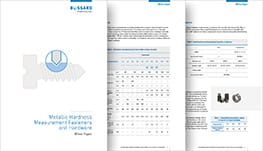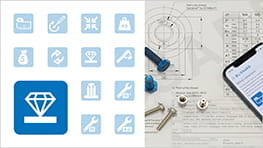Hardness testing is one of the most important procedures for assuring the quality of the materials used in a wide variety of industries and in research and development. As an experienced partner, Bossard is there to support you with its hardness testing expertise and its state-of-the-art test laboratories.
Hardness test - Determination of material properties
What is a hardness test?
Hardness testing is a common procedure for determining the properties of a material. Hardness describes the resistance that a material puts up against a penetrating object. This makes it possible to test whether it is a hard or brittle material, or one that is wear-resistant and tough. This allows the tester to determine whether the tested mate-rial is suitable for a particular purpose.
Hardness testing is used in all kinds of different areas and sectors to ensure the re-quired quality. The major industrial sectors where it is used include the automotive in-dustry, construction, aerospace, mechanical engineering, the metal production and pro-cessing industries, and the automation industry.
Advantages of a hardness test
- Relatively simple and quick test procedure
- Test takes place directly on component
- Minor changes to the tested material allow for further use
How a hardness test works
The principle of hardness testing is relatively simple: An indenter, i.e., an object with specific masses, is pressed into the surface of the material to be tested with a certain force. This process creates an indentation, the dimensions of which the tester can measure. The hardness can then be calculated based on this measurement. The small-er the indentation, the harder the material being examined. The tester has a choice of various methods.
Vickers hardness test*
The Vickers hardness test is based on an optical measurement system. Testing accord-ing to the Vickers scale relies on a pyramidal diamond with a square base. The tester measures the length of both diagonals of the indentation left behind by the diamond. They then use the average value of the diagonals to calculate the hardness, with the hardness value and the test force always being mentioned together (e.g., 350 Hv30). Because the indentation made by the diamond is very small, this measurement method is particularly suitable for small and very thin workpieces.
Rockwell hardness test*
The Rockwell hardness test (HRC) is performed using a diamond cone (120° point an-gle) to test the hardness of hardened steel. The tester first applies a preliminary force or a preliminary load to penetrate the surface of the material to be tested. After a cer-tain dwell time, the base depth – which serves as a reference level and comes into play later when calculating the hardness – can be measured. The test force is then further increased to achieve the final penetration depth. After a dwell time, the test force is reduced again and the final penetration depth is measured. The tester then calculates the Rockwell hardness value based on the difference between the base depth and the final penetration depth. The final result of the hardness value combined with the test procedure represents the Rockwell hardness (e.g., 58HRC).
Contact our experts and find out more about Bossard’s Expert Test Services. We look forward to hearing from you!
*Vickers hardness test accredited in Switzerland, Rockwell hardness test accredited in the U.S., see certificats.
Discover other modules that contribute to improving your productivity step by step
![]() Expert Education
Expert Education
Learn about the essentials and secrets of fastenings in our seminars and e-learning courses
![]() Expert Teardown
Expert Teardown
Identify the best fastening solution and cost saving potential for you
![]() Expert Design
Expert Design
Design your best product with a wide range of technical information and tools
Expert Walk
Study your fasteners and tools in use, we determine how to proceed leaner and smarter
![]() Expert Assortment Analysis
Expert Assortment Analysis
Reduce TCO by identifying opportunities for fastener rationalization





